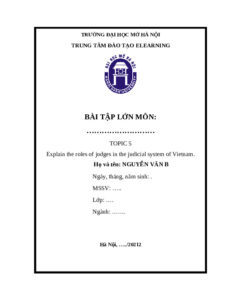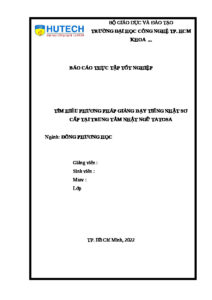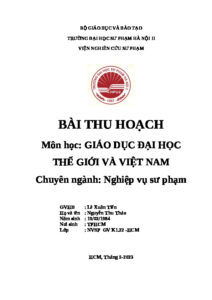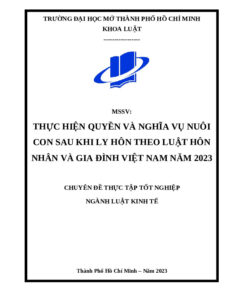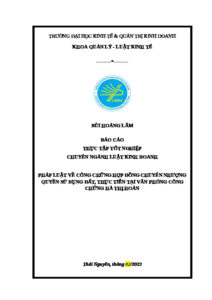The Factors Effecting Customer Satisfication In Viettel Post
Chủ đề: Các yếu tố ảnh hưởng đến sự hài lòng của khách hàng tại Bưu điện Viễn thông Topic: The Factors Effecting Customer Satisfication In Viettel Post
Bạn đang xem trước 15 trang tài liệu The Factors Effecting Customer Satisfication In Viettel Post, để xem tài liệu hoàn chỉnh bạn click vào nút DOWNLOAD ở trên
TOPIC: THE FACTORS EFFECTING CUSTOMER SATISFICATION IN VIETTEL POST Contents INTRODUCTION.....................................................................................................................................3 1. Research rationale...............................................................................................................................3 2. Research objectives and research questions......................................................................................4 2.1 Research objectives..........................................................................................................................4 2.1.1 General objective.........................................................................................................4 2.1.2 Detail objectives...........................................................................................................4 2.2 Research questions..........................................................................................................................4 3. Research subject and scope of study..................................................................................................4 3.1 Research subject..............................................................................................................................4 3.2 Scope of research.............................................................................................................................4 4. Research methodology........................................................................................................................4 5. Research structure...............................................................................................................................5 CHAPTER 1: THEORETICAL BASIS ON CUSTOMER SATISFACTION......................................6 1.1 Overview of the theoretical basis of customer satisfaction...........................................................6 1.1.1 The concept of customer satisfaction..........................................................................6 1.1.2 The importance of customer satisfaction to enterprises..................................................9 1.2 Some evaluation models of customer satisfaction........................................................................11 1.2.1 SERVQUAL . service quality model.........................................................................11 1.2.2 Oliver's expectations - Perception Model (1980).....................................................12 1.2.3 Fornell's American customer satisfaction index model (1992)...............................14 1.2.4 EU countries customer satisfaction index model..........................................................15 1.2.5 Model of Gronroos (1984).........................................................................................16 1.2.6 The Antecedent and Intermediate Model of Dabholkar (2000)..............................17 1.3 Previous studies.............................................................................................................................18 1.4 Proposed research model and research hypotheses....................................................................20 1.4.1 Research hypothesis development............................................................................20 1.4.2 Proposed research model...........................................................................................24 CHAPTER 2: RESEARCH METHODOLOGY...................................................................................26 2.1 Research process............................................................................................................................26 2.2 Build a draft scale..........................................................................................................................26 2.3 Research Methods.........................................................................................................................30 2.3.1 Qualitative research method.....................................................................................30 2.3.2 Quantitative research method...................................................................................30 2.4 Methods of data collection............................................................................................................31 2.4.1 Sampling method.......................................................................................................31 2.4.2 Sample size.................................................................................................................31 2.5 Methods of data analysis...............................................................................................................32 2.5.1 Reliability testing by Cronbach's Alpha coefficient................................................32 2.5.2 Exploratory factor analysis (EFA)............................................................................32 2.5.3 Regression analysis....................................................................................................32 CHAPTER 3: RESEARCH METHOLOGY AND FINDINGS SATISFACTION WHEN USING VIETTELPOST'S PRODUCTS AND SERVICES.........................................................................36 3.1 Descriptive statistics of the research sample................................................................................36 3.2 Test the reliability of the scale by Cronbach's Alpha coefficient...............................................38 3.3 Exploratory factor analysis (EFA)...............................................................................................40 3.3.1 EFA for independent variables.................................................................................40 3.3.2 EFA for dependent variables....................................................................................43 3.4 Pearson correlation analysis.........................................................................................................44 3.5 Regression analysis........................................................................................................................46 3.5.1 Regression model building........................................................................................46 3.5.2 Testing the goodness of fit of the model....................................................................46 3.5.3 Regression results.......................................................................................................47 3.5.4 Testing for violation of regression hypotheses.........................................................49 CHAPTER 4: CONCLUSIONS AND POLICY IMPLICATIONS.....................................................52 4.1 Conclusion......................................................................................................................................52 4.2 Recommendations and policy implications..................................................................................52 4.2.1 Reliability...................................................................................................................52 4.2.2 Service price...............................................................................................................53 4.2.3 Empathy.....................................................................................................................54 4.2.4 Tangibility...................................................................................................................55 4.2.5 Service capacity..........................................................................................................56 INTRODUCTION 1. Research rationale Customer satisfaction is a problem that has been widely concerned and studied by researchers at home and abroad in different fields. According to Zeithaml & Bitner (2000), customer satisfaction is defined as the customer's evaluation of products or services that meet their expectations. In, Bitner & Hubbert (1994) pointed out that the competitive advantage of enterprises is strongly inspired by customer satisfaction, in other words, customer satisfaction is an important factor that addition the competitive advantage of enterprises. For enterprises, customers play a very important role, because customers are the source of income and profits. Therefore, the goal of today's enterprises is to make customers satisfied with their products and revenues. On the other hand, according to Dick & Basu (1994), customer satisfaction is considered a key factor for all organizations that want to improve customer loyalty and make their business better. Customer satisfaction is also a consistent evaluation of past expected and perceived service performance (Chen and Wang, 2009). Therefore, the positive evaluation of customers' products or services is the main reason to promote the relationship with enterprises' services or products, and it is also an important factor to maintain loyalty. Therefore, according to Chen & Wang (2009), customer satisfaction and loyalty are crucial to the success and profitability of a company. Satisfied customers are easier to get, lower price sensitivity, actively participate in publicity and become loyal customers. In recent years, with an average growth rate of about 29% per year, Vietnam's e-commerce will continue to grow rapidly and reach the milestone of 52 billion USD by 2025. Only 6 months At the beginning of 2021, postal output reached over 590 million, an increase of 30% over the same period in 2020. This besides creating opportunities for postal businesses in general and Viettel Post in particular, also creates an environment. fierce competition in the postal sector. ViettelPost is a member unit of Military Telecommunications Group (Viettel), specializing in business services: Domestic and international express delivery, many different services such as: Courier Service (VCN), Service Express delivery service (VHT), Economy delivery service (VTK) , Plus service. In the past time, Viettel Post has had to compete fiercely with many foreign service providers such as TNT, DHL (USA) with a wide network around the world and famous brands. A large number of Vietnamese customers use international postal services. Not only competing with foreign companies, Viettel Post also has to share market share with a number of domestic enterprises such as VNPT, SaigonPost... In recent years, many businesses have provided transport services such as Hoang Long, Vinatrans,... also started to participate in the transportation of goods and parcels. Due to low freight rates, simple procedures, and fast delivery times, these businesses have become big competitors of Viettel Post. In the fierce competition environment among competitors in the same industry, customers have a decisive factor to the existence of postal enterprises in general and ViettelPost in particular. A business that wins customer satisfaction and loyalty will increasingly have a firm foothold in the market. The business strategy to attract new customers, maintain and strengthen old customers is becoming an effective strategy with small costs but high business efficiency. Many domestic and foreign studies have found evidence that proves the existence of a causal relationship of customer satisfaction and customer loyalty to products/services and to the organization. Therefore, it is necessary to have studies to determine the factors affecting customer satisfaction when using the services of the enterprise, as a result helping build solutions to increase customer satisfaction, therefore their loyalty to the company and to retain customers in today's increasingly competitive environment. Based on the above reasons, the author decided to choose “Factors Effecting Customer Satisfication In Viettel Post” as the topic of graduation thesis. 2. Research objectives and research questions 2.1 Research objectives 2.1.1 General objective The main objective of the study is to identify the factors and measure the influence of those factors on customer satisfaction when using Viettel Post's products/services. 2.1.2 Detail objectives On the basis of the main objective of the study, the study the following specific objectives: (1) Determining factors affecting customer satisfaction when using products/services of Viettel Post (2) Measure the influence of these factors on customer satisfaction when using products/services of Viettel Post (3) From the research results, policy implications are drawn 2.2 Research questions To achieve the goal, the research focus addressing the following questions : RQ1: What factors affect customer satisfaction when using ViettelPost's products/services? RQ2: How does each factor affect customer satisfaction when using ViettelPost's products/services? RQ3: What are the policy implications to help ViettelPost improve customer satisfaction when using the Company's products/services? 3. Research subject and scope of study 3.1 Research subject The research objects is the factors affecting customer satisfaction with products/services of ViettelPost. Survey subjects are customers who have been using ViettelPost's products/services. 3.2 Scope of research Scope of space:The study was conducted within the scope of customers using ViettelPost's products/services in Hanoi Scope of time:Survey data collected in April 2022 4. Research methodology This study uses both qualitative and quantitative research methods at the same time. The qualitative researchmethod was carried out with the specific method of structured interview with the interviewees being 05 experts who are sales and customer service department staff at ViettelPost in order to test the suitability of the model. The proposed research model, the scale of factors in the research model with the context of service industry research in Vietnam. Quantitative research methodwas carried outwith the data collection tool being a questionnaire with customers who are currently using Viettelpost's services in Hanoi. After collecting the necessary number of samples, the data is processed by SPSS 22.0 software to confirm that the scales are reliable and valid. To evaluate the proposed model and test the hypotheses, the factors will be calculated, then using the multivariate regression method. 5. Research structure In addition to the Introduction, Conclusion and Reference Parts the main content of the thesis consists of three as follow: CHAPTER 1: THEORETICAL BASIS ON CUSTOMER SATISFACTION 1.1 Overview of the theoretical basis of customer satisfaction 1.1.1 The concept of customer satisfaction There are many different definitions of customer satisfaction as well as a lot of debate about this definition: According to Fornell (1995) satisfaction or disappointment after consumption, is defined as the customer's response customers about assessing by feeling the difference between expectations before consumption and actual feelings about the product after consuming it. According to Oiver (1997), satisfaction is the consumer's response to the fulfillment of wants. These expectations include both the level of satisfaction above and below the desired level According to Parasuraman, Zeithaml, Berry (1993), customer satisfaction is a function of the evaluation of service quality, product quality products and customer prices. According to Kotler (2000), satisfaction is defined as “satisfaction as a feeling of satisfaction or disappointment of a person as a result of comparing the actual received product (or outcome) in relation to other their expectations”. Thus, it can be understood that customer satisfaction is the fact that customers base their knowledge on a product or service that forms subjective evaluations or judgments. It is a form of psychological feeling after a customer's need is satisfied. Customer satisfaction is formed on the basis of experiences, especially accumulated when purchasing and using products or services. After buying and using the product, customers will have a comparison between reality and expectations, thereby evaluating whether they are satisfied or not. If the actual benefits are higher than the customer's expectations, it will create a phenomenon of higher satisfaction or satisfaction that exceeds expectations and vice versa. Customer satisfaction is the perceived result of the value received by customers after using the organization's services and products (Hallowel, 1996). In her research, researcher Elizabeth T. Jones (2005) made the statement that if the bank can respond to customer's transaction requirements quickly, accurately and respectfully, staff attitude, Friendly, good information confidentiality, customers will feel satisfied. Customer satisfaction is the existence of the organization in the subconscious of customers when the organization's products and services meet and exceed customer expectations (Rigopoulou et al., 2008). . According to him, customer satisfaction is one of the important fruits of an organization's marketing activities. In her research, researcher Nguyen Thi Mai Trang (2008) made the conclusion that customer satisfaction is the most influential factor to explain customer loyalty. According to Kennedy and Schneider (2000), customer satisfaction in the banking sector plays an extremely important role and is a fundamental factor for the success of banks. He said that banks have realized that retaining existing customers is more profitable than competing to eliminate a competitor in the same industry to vie for new customers, the reason being that the cost of doing so is very high. big. Customers are the link connecting the success of the business. There are two important thresholds affecting the relationship between customer satisfaction and customer loyalty (Coyne, 1986). According to Oliva, Oliver & Macmillan (1992), loyalty increases significantly when customer satisfaction reaches a certain level. Customer satisfaction and loyalty need to be incorporated into the long-term goals of the business. When satisfaction decreases to a certain extent, loyalty also decreases significantly. According to Dick & Basu (1994), customer satisfaction is considered as a key factor for all organizations that want to enhance customer loyalty and make business performance better.. Satisfaction Customer satisfaction is also a consistent assessment between past expectations and perceived service performance (Chen and Wang, 2009). Accordingly, a customer's positive reviews of a product or service is a key driver of a relationship with a company's service or product, as well as an important factor in maintaining loyalty. Chen & Wang (2009) argue that customer satisfaction and loyalty are important to a company's success and profitability. Satisfied customers are more likely to repurchase, reduce price sensitivity, actively engage in propaganda, and become loyal customers. Fornell (1992) has clearly explained that customer loyalty can be seen as a derivative of customer satisfaction, and business customer satisfaction leads to customer loyalty. Positive customer reviews of a product or service are a key driver of a relationship with a company's service or product, as well as an important factor in maintaining loyalty. Chen & Wang (2009) argue that customer satisfaction and loyalty are important to a company's success and profitability. Satisfied customers are more likely to repurchase, reduce price sensitivity, actively engage in propaganda, and become loyal customers. Fornell (1992) has clearly explained that customer loyalty can be seen as a derivative of customer satisfaction, and business customer satisfaction leads to customer loyalty. Positive customer reviews of a product or service are a key driver of a relationship with a company's service or product, as well as an important factor in maintaining loyalty. Chen & Wang (2009) argue that customer satisfaction and loyalty are important to a company's success and profitability. Satisfied customers are more likely to repurchase, reduce price sensitivity, actively engage in propaganda, and become loyal customers. Fornell (1992) has clearly explained that customer loyalty can be seen as a derivative of customer satisfaction, and business customer satisfaction leads to customer loyalty. Wang (2009) argues that customer satisfaction and loyalty are important to a company's success and profitability. Satisfied customers are more likely to repurchase, reduce price sensitivity, actively engage in propaganda, and become loyal customers. Fornell (1992) has clearly explained that customer loyalty can be seen as a derivative of customer satisfaction, and business customer satisfaction leads to customer loyalty. Wang (2009) argues that customer satisfaction and loyalty are important to a company's success and profitability. Satisfied customers are more likely to repurchase, reduce price sensitivity, actively engage in propaganda, and become loyal customers. Fornell (1992) has clearly explained that customer loyalty can be seen as a derivative of customer satisfaction, and business customer satisfaction leads to customer loyalty. According to some researchers, customer satisfaction can be classified into three categories and they have different impacts on service providers: • Demanding customer satisfaction: this is positive satisfaction and is responded to through increasing demand for service providers. For customers with positive satisfaction, they and the supplier will have a good relationship, trust each other and feel satisfied when dealing. Moreover, they also hope that the service provider will be able to meet their increasing demand. Therefore, this is a group of customers who easily become loyal customers as long as they realize there are many improvements in service provision for them. The positive factor is also reflected in the fact that, • Stable customer satisfaction: for customers with stable satisfaction, they will feel comfortable and satisfied with what is going on and do not want a change in the way service is provided. service. Therefore, these customers appear to be comfortable, have high trust in and are willing to continue using the service (Parasuraman, Zeithaml, Berry, 1993). • Resigned customer satisfaction: customers with passive satisfaction have little trust and they think that it is difficult for the supplier to improve service quality and change according to their requirements . They feel satisfied not because their needs have been completely satisfied, but because they think it is impossible to ask the supplier to improve. Therefore, they will not actively contribute ideas or appear indifferent to improvement efforts. It should also be added that in addition to classifying customer satisfaction, the level of satisfaction also greatly affects customer behavior. Even if customers have the same positive satisfaction with the service provider but the satisfaction level is only "satisfied", they may also look elsewhere and not continue to use the service of the service provider. supplier. Only customers with the highest level of satisfaction "very satisfied" will certainly be loyal customers (Parasuraman, Zeithaml, Berry, 1993). 1.1.2 The importance of customer satisfaction to enterprises According to Parasuraman et al. (1991). In the marketing literature, customer satisfaction has been assessed as an important factor affecting customer loyalty (Gerpott et al., 2001; Kumar et al., 2013; Kim et al., 2015a; Kim et al., 2016). Omachonu et al. (2008) argue that customer satisfaction is a psychological state in which there is a consistency between perceived reality and expectations. Gerpott et al. (2001) reported that satisfied customers tend to maintain their purchasing patterns. Grönholdt et al. (2000) show that customer loyalty is a function of customer satisfaction and that customer loyalty affects the financial performance of the company. Wong and Zhou (2006), Aktepe et al. (2015) and Chang (2015) clearly show that satisfaction is one of the main factors affecting customer loyalty. Customer satisfaction and loyalty need to be incorporated into the long-term goals of the business. When satisfaction decreases to a certain extent, loyalty also decreases significantly. According to Dick & Basu (1994), customer satisfaction is considered a key factor for all organizations that want to enhance customer loyalty and make business better. Accordingly, according to Chen & Wang (2009), customer satisfaction and loyalty play an important role in the success and profitability of the company. Satisfied customers are more likely to repurchase, reduce price sensitivity, actively engage in publicity, and become loyal customers Customer satisfaction and loyalty need to be incorporated into the long-term goals of the business. When satisfaction decreases to a certain extent, loyalty also decreases significantly. According to Dick & Basu (1994), customer satisfaction is considered a key factor for all organizations that want to enhance customer loyalty and make business better. Accordingly, according to Chen & Wang (2009), customer satisfaction and loyalty play an important role in the success and profitability of the company. Satisfied customers are more likely to repurchase, reduce price sensitivity, actively engage in publicity, and become loyal customers Customer satisfaction and loyalty need to be incorporated into the long-term goals of the business. When satisfaction decreases to a certain extent, loyalty also decreases significantly. According to Dick & Basu (1994), customer satisfaction is considered a key factor for all organizations that want to enhance customer loyalty and make business better. Accordingly, according to Chen & Wang (2009), customer satisfaction and loyalty play an important role in the success and profitability of the company. Satisfied customers are more likely to repurchase, reduce price sensitivity, actively engage in publicity, and become loyal customers According to Dick & Basu (1994), customer satisfaction is considered a key factor for all organizations that want to enhance customer loyalty and make business better. Accordingly, according to Chen & Wang (2009), customer satisfaction and loyalty play an important role in the success and profitability of the company. Satisfied customers are more likely to repurchase, reduce price sensitivity, actively engage in publicity, and become loyal customers According to Dick & Basu (1994), customer satisfaction is considered a key factor for all organizations that want to enhance customer loyalty and make business better. Accordingly, according to Chen & Wang (2009), customer satisfaction and loyalty play an important role in the success and profitability of the company. Satisfied customers are more likely to repurchase, reduce price sensitivity, actively engage in publicity, and become loyal customers According to Bitner & Hubbert k (1994), customer satisfaction has become an important factor to create a competitive advantage for businesses. In the context of the current market economy, all businesses have an operating motto that is to satisfy the needs of their customers or, in other words, to make their customers maximally satisfied with their products. and service quality of your business because customers are the source of revenue and profit of the business. When customers are satisfied with the company's products or services, they are more likely to buy again. Moreover, when they are satisfied, they tend to speak positively about the company's services. 1.2 Some evaluation models of customer satisfaction 1.2.1 SERVQUAL . service quality model For a long time, many researchers have tried to define and measure service quality. Gronroos (1984) suggested that two components of service quality are technical quality (what the customer receives) and functional quality (how the service is delivered). However, when it comes to service quality, we cannot fail to mention the great contribution of Parasuraman et al (1988, 1991). The first is the 1985 model that says that service quality is assessed in the gap year (gap), the five difference model is a general, theoretical model of service quality. In order to be practical, Parasuraman & ctg have tried to build a scale used to assess quality in the service sector, according to him, any service quality is perceived by customers based on the following 10 components: : Reliability, Responsiveness, Competence, Access, Communication, Courtesy, Credibility, Security , Understanding of customers (Understanding), Tangibles. In 1988, Parasuraman & ctg revised and formed a new model consisting of 5 components. That is the SERVQUAL model: Reliability: demonstrated through the ability to perform the right service and on time the first time. Employee's ability to deliver on promises accurately. Responsiveness: expressed through the desire and willingness of employees to help customers in a timely manner. Service capacity (Assurance): expressed through professional qualifications and service to customers. Empathy: showing care for each individual customer. Tangibles: includes physical assets, equipment. Since its launch, SERVQUAL has proven very useful for assessing service quality. Some researchers believe that, at a general level, the 5-component structure of the SERVQUAL scale can serve as a meaningful conceptual framework to summarize the criteria that customers use to evaluate service quality. service, and at the same time they also instruct: SERVQUAL should be used in its entirety, may add to SERVQUAL service-specific questions, but must be similar to SEVQUAL's questionnaires and will be on the way to a later date. Among the components of SERVQUAL, SERVQUAL can be effectively supplemented with qualitative or quantitative studies to uncover the cause of gaps identified by SERVQUAL. 1.2.2 Oliver's expectations - Perception Model (1980) The model “Expectations - Perceptions” of Oliver (1980) was introduced to study the assessment of customer satisfaction, which refers to two small processes that independently affect customer satisfaction. It is the expectation of the service before buying and the actual feeling of the service after the experience. According to this model, before using the service, the customer has formed in his mind the expectations about the elements constituting the quality of the service that the provider can bring to them. Then, the purchase and use of the service will form the customer's actual perception of the actual performance of the service they use. By comparing what they expect before using the service with what they actually get after using, customers will have confirmation compared to expectations. There are 3 possibilities that will happen with this model: (1) If the actual perception completely coincides with the
Tài liệu liên quan
Topic 5 Explain the roles of judges in the judicial system of vietnam
Topic 5 Explain the roles of judges in the judicial system of vietnam Chủ đề 5 Giải thích vai trò của thẩm phán trong hệ thống tư pháp Việt Nam
Solutions To Mprove The Operational Performance Of Vietnam Bank For Industry And Trade Securities Joint Stock Company Vietinbank Securities
Topic: Solutions To Mprove The Operational Performance Of Vietnam Bank For Industry And Trade Securities Joint Stock Company (Vietinbank Securities)
Báo Cáo Thực Tập Ngoại Ngữ Tại Đại Học Bình Dương
Báo Cáo Thực Tập Ngoại Ngữ Tại Đại Học Bình Dương Ministry of training and education Bình dương university Faculty of foreign languages
Báo Cáo Thực Tập Chuyên Ngành Ngôn Ngữ Anh Đại Học Hải Phòng
Báo Cáo Thực Tập Chuyên Ngành Ngôn Ngữ Anh Đại Học Hải Phòng, dành cho các bạn sinh viên đang tìm kiếm đề tài ngành ngoại ngữ anh
A Study On Activities To Improve In Service Students Reading Skills At Tay Nguyen University
The Outline Of Graduation Assignment Title: A Study On Activities To Improve In-Service Students’ Reading Skills At Tay Nguyen University
Phương Pháp Giảng Dạy Tiếng Nhật Sơ Cấp Tại Nhật Ngữ Tatosa
Báo Cáo Thực Tập Tốt Nghiệp Tìm Hiểu Phương Pháp Giảng Dạy Tiếng Nhật Sơ Cấp Tại Trung Tâm Nhật Ngữ Tatosa Ngoài phần mở đầu và kết luận, nội…
Xem nhiều nhất
Bài Kiểm Tra Cuối Kỳ Học Phần Quản Trị Rủi Ro Có Lời Giải
Bài Kiểm Tra Cuối Kỳ Học Phần Quản Trị Rủi Ro Có Lời Giải Câu 1: Chức danh nhân viên kinh doanh bán hàng có các công việc nào phải…
Bài Thu Hoạch Môn Học Giáo Dục Đại Học Thế Giới Và Việt Nam Chuyên Ngành Nghiệp Vụ Sư Phạm
Bài thu hoạch Môn học: giáo dục đại học thế giới và việt nam Chuyên ngành: nghiệp vụ sư phạm
Tiểu Luận Quan Điểm Của Chủ Nghĩa Mác-Lê Nin Về Giai Cấp Công Nhân Và Sứ Mệnh Lịch Sử Của Giai Cấp Công Nhân
Tiểu Luận Quan Điểm Của Chủ Nghĩa Mác-Lê Nin Về Giai Cấp Công Nhân Và Sứ Mệnh Lịch Sử Của Giai Cấp Công Nhân
Khóa Luận Thực Hiện Quyền Và Nghĩa Vụ Nuôi Con Sau Khi Ly Hôn Theo Luật Hôn Nhân Và Gia Đình Việt Nam Năm 2023
Chuyên Đề Thực Tập Tốt Nghiệp Thực Hiện Quyền Và Nghĩa Vụ Nuôi Con Sau Khi Ly Hôn Theo Luật Hôn Nhân Và Gia Đình Việt Nam Năm 2023 Mục…
Tiểu Luận Nguồn Gốc Ra Đời Của Nhà Nước Và Pháp Luật Theo Học Thuyết Chủ Nghĩa Mác- Lênin
Tiểu Luận Nguồn Gốc Ra Đời Của Nhà Nước Và Pháp Luật Theo Học Thuyết Chủ Nghĩa Mác- Lênin dành cho các bạn sinh viên đang tìm kiếm về bài…
Pháp Luật Về Công Chứng Hợp Đồng Chuyển Nhượng Quyền Sử Dụng Đất, Thực Tiễn Tại Văn Phòng Công Chứng Hà Thị Hoàn
Báo cáo Thực tập tốt nghiệp Chuyên ngành luật kinh doanh pháp luật về công chứng hợp đồng chuyển nhượng quyền sử dụng đất, thực tiễn tại văn phòng công…


